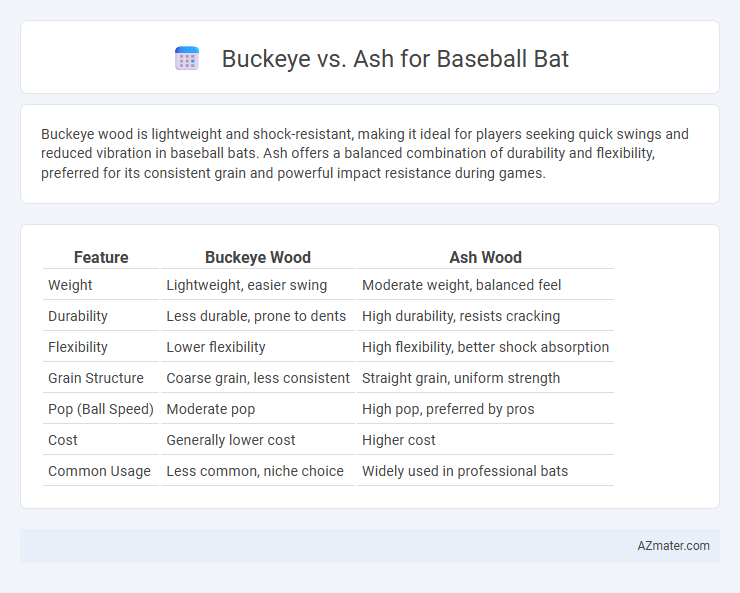Buckeye wood is lightweight and shock-resistant, making it ideal for players seeking quick swings and reduced vibration in baseball bats. Ash offers a balanced combination of durability and flexibility, preferred for its consistent grain and powerful impact resistance during games.
Table of Comparison
| Feature | Buckeye Wood | Ash Wood |
|---|---|---|
| Weight | Lightweight, easier swing | Moderate weight, balanced feel |
| Durability | Less durable, prone to dents | High durability, resists cracking |
| Flexibility | Lower flexibility | High flexibility, better shock absorption |
| Grain Structure | Coarse grain, less consistent | Straight grain, uniform strength |
| Pop (Ball Speed) | Moderate pop | High pop, preferred by pros |
| Cost | Generally lower cost | Higher cost |
| Common Usage | Less common, niche choice | Widely used in professional bats |
Introduction to Buckeye and Ash Wood for Baseball Bats
Buckeye wood for baseball bats is known for its lightweight and flexibility, making it a popular choice among players seeking enhanced bat speed and control. Ash wood offers a balanced combination of strength and elasticity, favored for its durability and distinctive grain that provides a responsive feel upon contact. Both materials contribute unique performance characteristics, influencing a player's swing dynamics and overall batting experience.
Physical Properties: Buckeye vs Ash
Buckeye wood, known for its lightweight and moderate density, offers a unique balance of strength and flexibility, making it suitable for baseball bats where maneuverability is key. Ash wood features a higher density and excellent shock absorption, providing durability and a solid feel on impact, preferred by players seeking power and control. The grain structure of Ash allows for a more consistent "pop," while Buckeye's softer texture may reduce vibration but can wear faster under high impact.
Weight and Swing Performance Comparison
Buckeye baseball bats typically offer a lighter weight design, enhancing swing speed and control, while Ash bats are heavier, providing greater power and stability at the expense of quickness. The lighter Buckeye bats improve bat maneuverability and reduce fatigue during extended play, making them ideal for players prioritizing quick hand speed. Conversely, Ash bats deliver a balanced swing experience with solid impact feedback, favored by hitters seeking a powerful, consistent swing despite a slightly slower bat speed.
Durability and Lifespan of Each Wood
Buckeye wood baseball bats offer moderate durability, known for their relatively lightweight and flexibility but tend to have a shorter lifespan due to their softer grain structure. Ash bats are prized for their combination of strength and elasticity, providing greater durability and a longer lifespan compared to Buckeye, as the wood's open grain pattern absorbs impact effectively without compromising integrity. Players seeking bats with extended use often prefer Ash for its balance of resilience and lightweight performance.
Grain Structure and Its Impact on Bat Quality
Buckeye bats exhibit a tighter grain structure compared to Ash, resulting in enhanced durability and a solid feel at impact, favored by players seeking reliability and consistent performance. Ash's more open grain allows for greater flexibility and a lighter swing weight, providing a lively bat speed but potentially sacrificing long-term durability. Understanding the grain pattern is crucial, as Buckeye's close grains contribute to better shock absorption and reduced likelihood of bat breakage, making it a preferred choice in high-intensity play.
Shock Absorption and Player Comfort
The Buckeye baseball bat features advanced shock absorption technology with its composite barrel and cushioned handle, significantly reducing vibration and minimizing player discomfort during impact. In contrast, Ash bats are known for their natural flex and lighter feel, offering moderate shock absorption but higher vibration transmission on mishits. Players prioritizing maximum comfort and reduced hand sting often prefer Buckeye bats, while those valuing traditional feel may lean toward Ash options.
Popularity Among Professional Players
Buckeye baseball bats are favored by professional players for their durability and high-performance design, often crafted from premium-grade maple wood that offers a solid hit and excellent feel. Ash bats, while less common in modern professional leagues, are still appreciated for their lightweight nature and traditional flex, appealing to players who value a balance of power and bat speed. The popularity of Buckeye bats in professional baseball highlights a trend towards denser wood types for enhanced strength and longevity in gameplay.
Cost Differences and Market Availability
Buckeye baseball bats generally offer a lower price point compared to Ash bats due to the more abundant availability of Buckeye wood and its slightly less labor-intensive manufacturing process. Ash bats command higher prices driven by their lightweight properties, flexibility, and premium market demand, which often results in limited availability in mainstream sporting goods stores. The cost difference is further influenced by seasonal supply fluctuations and brand positioning, with Ash bats often stocked in specialty shops and Buckeye bats more commonly found in mass-market outlets.
Customization Options for Each Wood Type
Buckeye baseball bats offer extensive customization options including personalized engraving, choice of barrel and handle styles, and balanced weight distribution tailored to player preferences. Ash bats provide natural grain variations that enhance flexibility and are often customized with grip textures and finish styles that highlight the wood's lightness and responsiveness. Both wood types allow players to select length, weight, and knob design, but Buckeye emphasizes aesthetic personalization while Ash focuses on optimizing performance through wood characteristics.
Final Verdict: Choosing the Right Wood for Your Bat
Buckeye wood offers a lightweight design with decent durability, making it suitable for players seeking better swing speed and control, while ash provides a more traditional feel with excellent flexibility and shock absorption favored by power hitters. Both woods exhibit distinctive grain patterns influencing performance and bat longevity; ash is known for larger pores that enhance flexibility, whereas Buckeye's tighter grain promotes a denser, harder hitting surface. Final verdict depends on the player's style: select Buckeye for agility and precision, or choose ash for a balanced combination of power, durability, and vibration reduction.

Infographic: Buckeye vs Ash for Baseball Bat
 azmater.com
azmater.com